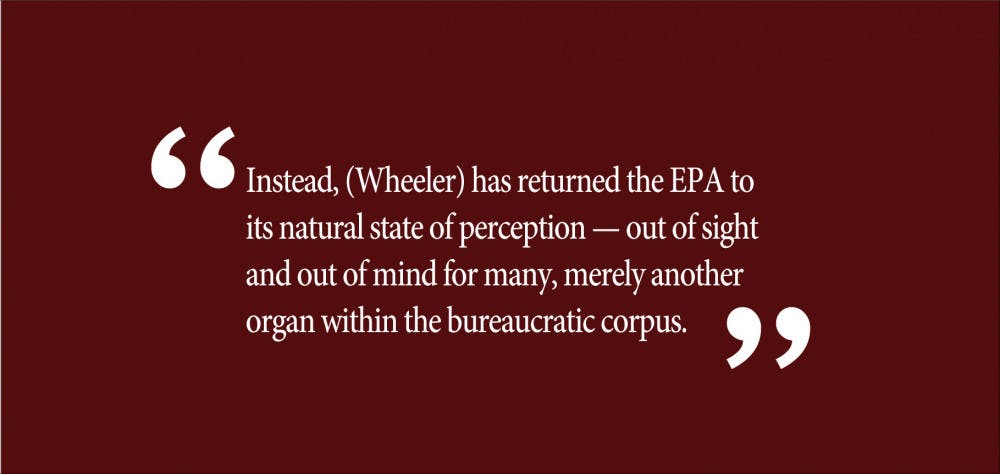I first visited Yosemite National Park when I was six years old. Small in stature, I was a precocious asthmatic. I spent my early years in the smoggy metropolis of Los Angeles, with scant opportunities to take a deep breath. But traveling upstate — into that valley of massive sequoias and granite cliff sides — proved a respiratory revelation for my younger self. I ran along the banks of the Merced River with newfound energy, as the purity of land and air mingled in perfect harmony.
Throughout the years, the untaintedness of national parks — which captured my imagination as a boy — has been maintained through rigorous legislation. The Regional Haze Rule, enacted by the Environmental Protection Agency in 1999, set lofty standards for “visual air clarity” in federally protected lands. As encroaching air pollutants threatened to breach these natural havens, a responsive EPA ensured that these parks would remain untouched. National parks are, after all, the last vestige of the country’s frontiersman past, a jewel against unfettered urbanization. They are also remarkably popular — a 2018 Pew poll found that 76 percent of respondents supported a $6.5 billion spending package for the National Parks Service. It seemed impossible that a government official would ever place these natural refuges in the firing line of human pollution.
That belief, of course, was a failure of my imagination. Andrew Wheeler, the newly confirmed administrator of the EPA, has spent his career in the private sector working to roll back such protections. A former coal lobbyist, Wheeler has been the EPA’s de facto leader since Scott Pruitt’s resignation in July 2018. He is also a far more salient threat to the environment than his predecessor. On Feb. 28, he was confirmed by the Senate with a 52-47 margin; Sen. Susan Collins, (R-ME), was the one dissenter in a vote split otherwise entirely along party lines.
Certainly, Pruitt was a similarly blasphemous choice to head the EPA; a climate change denier, he sued the agency 14 times during his tenure as Oklahoma Attorney General. But Pruitt’s capacity for enduring damage was undermined by his penchant for malfeasance — he was equally concerned with rolling back emission standards as he was with finding a specific brand of hotel moisturizer. Pruitt’s comical mishaps invited media attention, thus nurturing a broader conversation regarding the EPA and its newfound ideology of anti-environmentalism. By elevating the visibility of the institution, he granted Democrats the latitude to discuss not only his public scandals, but also his environmental rollbacks.
Wheeler, conversely, is far harder to vilify. There are no scandals, and fewer on-air appearances. Instead, he has returned the EPA to its natural state of perception — out of sight and out of mind for many, merely another organ within the bureaucratic corpus. Wheeler is the consummate Washington insider, well-equipped to avoid the media fracas of Pruitt’s tenure.
Wheeler began his career at the EPA; spent over a decade as a top aide to Sen. Jim Inhofe, the Oklahoma Republican who published a book entitled “The Greatest Hoax: How the Global Warming Conspiracy Threatens Your Future”; and was most recently a lobbyist for Murray Energy Corporation, the self-described “largest coal company in America.”
Ideologically, there will be no change between Pruitt and Wheeler. Myron Ebell, another prominent crusader against scientific consensus, encapsulated the continuity between the two EPA leaders. “There will be no noticeable shift from the Pruitt agenda to the Wheeler agenda,” Ebell told The Atlantic in 2018, “because it’s really the Trump agenda.” That agenda, concisely, is the unabashed destruction of former EPA legislation.
And Wheeler has pursued such rollbacks with a sort of quiet vigor. While he has faded into the background of the media landscape — becoming but another faceless cabinet secretary — his campaign against environmental protection has accelerated. There is his aforementioned subversion of the Regional Haze Rule, which releases states from the direct responsibility of maintaining air standards in federally reserved lands. He has proposed a replacement for the 2015 Clean Water Rule, which would eliminate protections from 60 percent of rivers, lakes and streams, thus threatening major sources of drinking water. And as a nod to his fraternity of coal lobbyists, Wheeler has revised an Obama-era restriction on mercury emissions, which will allow coal plants to release far more of the brain-damaging compound into the air.
Yet Wheeler’s scorched-earth agenda has not garnered the attention that defined Pruitt’s tenure. Certainly, plenty of Wheeler’s actions are scandal-worthy; a 2018 New York Times expose, for example, uncovered the substantial role that oil interests played in a Wheeler-led rollback of automobile emission standards. But suspect legislation is unlikely to capture media attention; it is not a scandal made for TV, unlike Pruitt’s use of EPA funds to charter private planes. And without a villain that can match Pruitt’s notoriety, environmentalists are left with a familiar — and impossible — challenge: to persuade a perpetually-distracted populace that an arcane, incremental bureaucratic process actually puts the country at risk of inhaling toxins, drinking contaminated water and accruing ever more heat-trapping air. All the while, oceans continue to rise. The planet continues to warm.
Derek Simshauser ’20 can be reached at derek_simshauser@brown.edu, or followed on Instagram @dsimshauser. Please send responses to this opinion to letters@browndailyherald.com and op-eds to opinions@browndailyherald.com.





